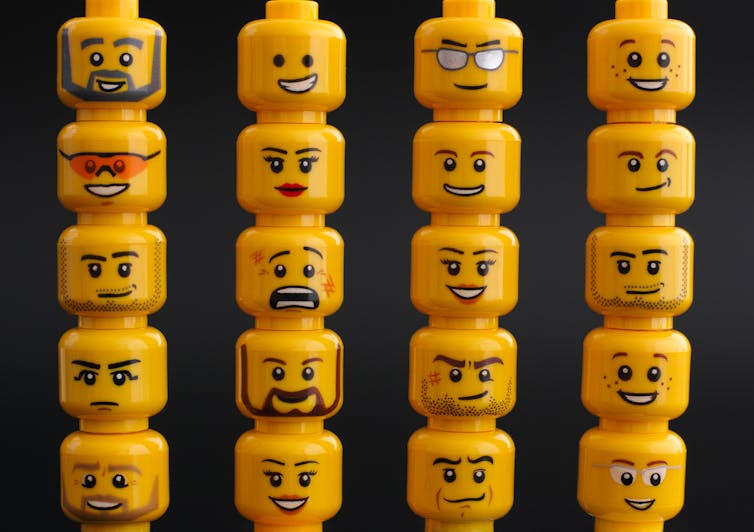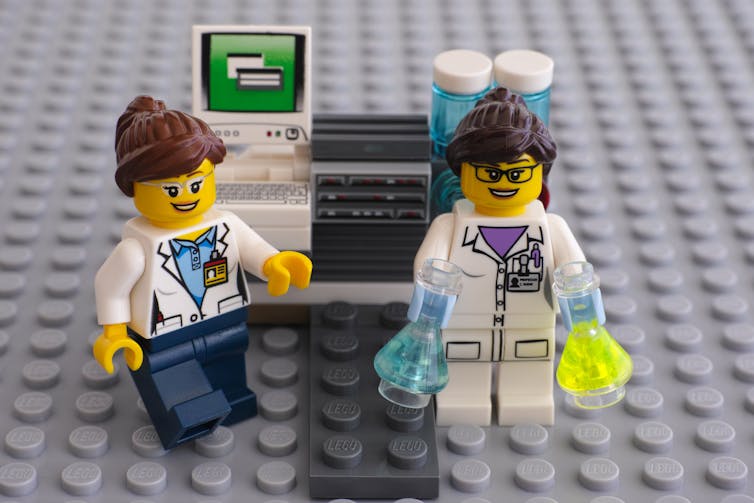You might think Lego is just a kids’ toy – one you played with as a child and now step on as you walk through the house as a parent.
These days, however, the bricks are showing up in all sorts of unexpected places – on display in museums, in street art, in home renovations and at work. Those playing with Lego are unexpected too, including artists like Ai Weiwei, corporate business people facilitating a work function or engineers designing sophisticated robotics.
Our recent book, LEGO and Philosophy, offers a new perspective. These brightly coloured bricks are not mere child’s play. They raise important and challenging questions about creativity and play, conformity and autonomy, identity and culture.

Not just for kids
Interest in Lego has recently extended beyond simple child’s play. Sociologists, psychologists and economists have studied the use of Lego bricks as tools for achieving certain ends via Lego-based therapy and similar activities.
Read more: Blocks are still the best present you can buy children for Christmas
Tools are for using, building, working, thinking, teaching, imagining, playing and much else. In fact, tools can be for anything. As soon as we realise Lego is a tool, its uses beyond mere play are obvious. Indeed, it is a universal tool that can be used to make anything we can imagine.
The company Lego Group is well aware of the bricks’ role as a universal tool for the imaginination: one of its most successful advertisement campaigns carried the minimal tagline “imagine”.
Structured thought, brick by brick
This is also where we need to be more reflective, more critical and perhaps even wary of the largest toy company selling the primary tool for children’s minds. Do we really want a for-profit company, whose commercial and financial interests are front and centre, governing what our children think and directing how our children imagine? Here are some of the highlights from our book, and areas of improvement, for Lego in its role as a tool for thinking.
Lego’s tagline, “imagine”, implies that one’s own imagination is the only limit to what you can build. Of course, that’s not quite right. One of the book chapters explores the ways in which Lego comes with some inbuilt constraints, and how those limits actually help inspire sophisticated Lego builders.
Some of those limits lie in the nature of the bricks. With each set, we can build a world of our own creation, both literally and metaphysically. Another chapter explores the similarities between Lego worlds and our own world, constructing a metaphysics of the bricks.
Instructions constitute another set of limits for Lego creations - assuming, at least, that you’re the kind of player who follows the rules. And here we come to a divide in Lego users between those who follow the rules dogmatically, and those who ditch them altogether, in favour of free play. The Lego Movie mocks these two kinds of Lego users in exaggerated characters.
Lego sets, complete with a metaphysics and rules, profoundly shape the world in which we live. Sometimes Lego does this well, but not always.
Is Lego constructing your world?
The problem of Lego shaping what and how we think has come to the fore recently with the company’s increased gender-based marketing, as Rhiannon Grant and Ruth Wainman worry in their book chapter.
When Lego produces materials for children that assume girls are more interested in characters, stories and emotions, and boys are more interested in building, cars and explosions, they are both playing into a dominant cultural narrative that tells children how they should be, and helping to create a world in which children are shaped to fulfil those expectations.
This explains why so many objected in 2012 to the pink-and-purple Lego Friends, designed to appeal to girls’ feminine desire to care for animals or play house. As Rebecca Gutwald reminds us:
… the problem with Friends is that they seem to be presented as the only options for girls in this Lego world and in the world in general.
The fact that Lego Friend characters are not designed to be attached to the regular blocks creates a literal gender divide during playtime.

Of course, there is some good news: not long after Lego Friends were introduced, Ellen Kooijman’s all-female research institute set (above) was allowed to go into production. But it was quickly retired and it nevertheless buys into a gender-based conception of girls’ play.
Apart from building the equipment and figures, no engineering or scientific skills are embedded in playing with the set.
Breaking down racial stereotypes
That said, Lego has had more success with the issues around race and ethnicity. Its original all-yellow minifigures may seem to embody an idealistically well intentioned, racial neutrality, but Lego’s representation of race has tracked the changes in society’s own assumptions about race. The bricks and figures are tools for showing us how we think, and for encouraging us to change how we think about race.
This is an opportunity for Lego. If it is a tool for building anything, then it also is a tool for constructing new paradigms through which to think about race, gender and social justice. As Tyler Shores highlights in his chapter, Lego has the power to challenge the status quo, to encourage critical thinking and deep reflection about the world and to help children and adults alike to rethink the way we should inhabit this planet.
Now that would make the popular bricks a truly innovative and creative tool for the future.

